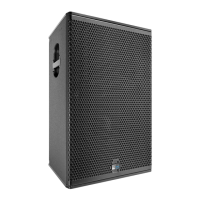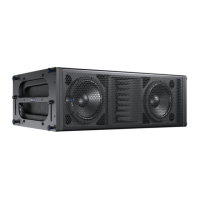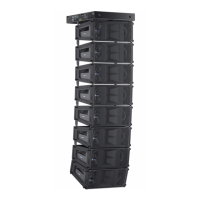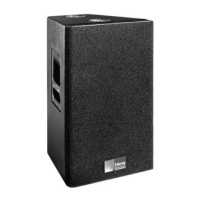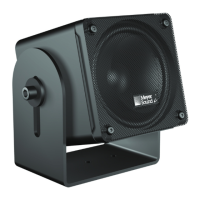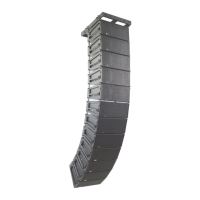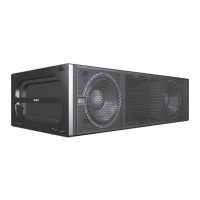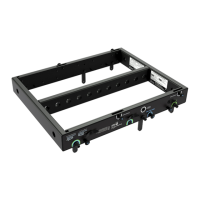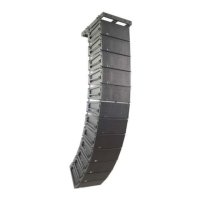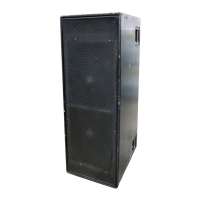8
Rigging
The DS-2P weighs 221 lb (100 kg). The maximum recom-
mended load for a single cabinet with aircraft pan fittings
is 600 lb (273kg). This working load is based on a 5:1 safety
factor. The DS-2P has six rigging brackets (three on top
and bottom). Each bracket is capable of supporting the
full working load of the cabinet.
There are four types of interchangeable rigging brackets,
each fastened by six Phillips screws:
• aircraft pan fittings (ring and stud)
•
3
/8”-16 nut plates
• M-10 x 1.5 metric nut plates
• blank plates (if no rigging brackets are requested)
NOTE: Units with nut plates are rated for the weight of
one cabinet only.
rigging brackets
three on top, three on bottom
Handles are for carrying only.
Do not use them for rigging!
!
Rigging load ratings assume a straight tensile pull and
that the cabinet is in new condition with aircraft pan
fittings. If these conditions are not met, the load ratings
can be reduced significantly. Load ratings can also be
reduced by age, wear, and damage. It is important to
inspect the rigging hardware regularly and replace worn
or damaged components immediately.
The cabinet, exposed electronic circuitry, and drivers can
receive protective treatment that permits safe use in wet
conditions. Additionally, a rain hood can be fitted to
shield cables and electronics. Do not install a unit outdoors
without weather protection! Contact Meyer Sound for more
information.
NOTE: All Meyer Sound products must be used in accor-
dance with local, state, federal, and industry regulations.
It is the owner’s and/or user’s responsibility to evaluate
the reliability of any rigging method for their application.
Rigging should be done only by experienced professionals.
Measurement and System
Integration Tools
It is essential that even the most carefully assembled
sound systems be analyzed with precise measurement
tools. We recommend using the Meyer SIM® System II
Sound Analyzer and CP-10 Parametric Equalizer to
• assist the process of choosing and configuring
speakers;
• measure propagation delays between subsystems
to set the correct polarity and delay times;
• measure and equalize variations in frequency
response caused by the acoustical environment
and the placement and interaction of speakers.
Contact Meyer Sound for assistance with your application.
We recommend using the Meyer LD-1A Line Driver to
integrate different types of Meyer self-powered speakers
into a complete system. The LD-1A has two channels
equipped to control a full-range main system, and six
auxiliary channels for down-fill, front-fill, and delay
systems. The LD-1A maintains signal integrity for long
cable paths and provides the following useful functions:
• The Lo Cut switch activates a high-pass filter
(160 Hz, –12 dB/oct, Q = 0.8) that performs a
crossover function for the Mid-Hi output.
• The DS-2 & Sub Crossover switch (channels 1 and
2 only) activates a crossover network optimized
for the DS-2P when used with the PSW-2 or 650-P.
With the switch in, frequencies below 80 Hz are
sent to the Sub output (for the 650-P), and above
80 Hz to the DS-2 output. When the subwoofer is
used without the DS-2P, (or the DS-2P is used
alone as a subwoofer) the switch should be out,
which sends a full-range signal to both the DS-2
and Sub outputs.
• The DS-2 φ and Sub φ switches (channels 1 and 2
only) toggle the polarity for the DS-2 and Sub
outputs.
• The Mid-Hi, DS-2, and Sub outputs (channels 1
and 2 only) each have their own gain control and
mute switch.
POLARITY NOTE: The polarity for Meyer self-powered
speakers may be reversed using the input polarity switch
on the user panel. The LD-1A also allows polarity reversal
with the
DS-2 φ
and
Sub φ
switches for speakers
connected to the DS-2 and Sub outputs. When making
polarity decisions in applications that include the LD-1A,
check the state of all polarity switches.
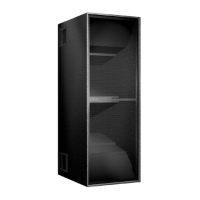
